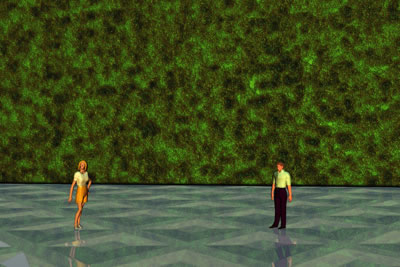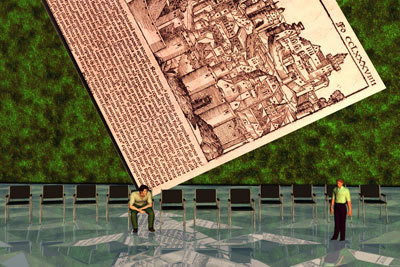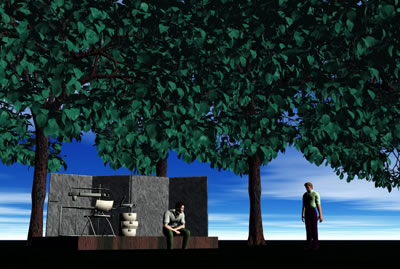
 |
 |
 |
Prelude The orchestra plays about half of the prelude with the curtain closed. Slowly, the curtain begins to open to reveal darkness. As the music progresses, the lights slowly begin to illuminate the scene. The setting consists of a very tall hedge wall. As the prelude comes to its climax and the lights become brighter, we become aware that we are watching dawn breaking over the city of Nuremberg. A figure moves slowly across the stage. This is the Night Watchman who is now doing his last round of the city before the sun comes up. As the last chords of the prelude come to an end, the lights come up full, and the Night Watchman disappears. Act I The Church of St. Katharine The lights are up full now. From backstage we can hear the sounds of the faithful attending an early service at the church of St. Katharine. This famous church as well as the city of Nuremberg that Wagner loved and which inspired him to write this opera was destroyed during the 20th century. In this production, the Nuremberg of Wagner's opera, now a Nuremberg that no longer exists, is recreated through the use of pictures, woodcuts, and engravings of the ancient city. Each of the acts has at least one monumental reproduction of a section of the old city which serves as the backdrop for the scene. The characters always wear costumes which are either modern or contemporary. In the first scene of the opera, Walther meets Eva inside St. Katharine's, since the church no longer exists, they meet in the emptiness of the stage. Emptiness in the first act serves as a metaphor for the loss of the city. Likewise, the historical place for the mastersingers to meet was the church. Now chairs are brought on the stage, and from the rafters descends a monumental reproduction of a woodcut of the ancient walled city. The fact that it is tipped over on its side, should also remind us of the fact that things are not the same anymore when it comes to the city of Nuremberg. Although the production mourns the loss of the city, the opera is a joyful and wise comedy that affirms life and holds up a mirror in order to present both the wise and the folly that is found in human nature. A very important factor of this production is the use of trees in every scene of the opera. Not only are certain kind of trees mentioned in Wagner's libretto, but trees in full bloom add a living component to the scenery, and end up representing life. The trees in this production should always be lit in the most handsome and imaginative way possible. The audience should remember the trees more than the visual representations of the city of Nuremberg. |
 |
 |
| Act II A Street in Nuremberg The curtain rises on a stage dominated by a huge wall where an equally huge photo-montage of a street in the old city has been posted. This gigantic image is a jumbled, jigsaw puzzle-like creation which looks like a cubist interpretation of a medieval street. It is late evening, and the sun will soon set. The horizon is visible behind the photo-montage, further giving this setting a highly theatrical and artificial feel. At either side of the photo-montage there are oversized apple or lime trees in full summer bloom. Whereas this depiction of a street in Nuremberg aims for totally artificial results, the trees, on the other hand, should look as realistic as possible, with green leaves and realistic trunks. Stage-right we find Hans Sachs's cobbler shop. It should be presented as minimally as possible. It consists of a raised platform. A screen upstage can give the feeling of walls as well as serving as an acoustical aid. A modern work desk with a chair is on the platform. It is understood that Pogner's house is across from Sachs's shop, therefore the majority of the action involving Walther and Eva occurs stage-left. Likewise, when Beckmesser comes to serenade Eva he also directs his song to this section of the stage. Eva and Walther's hideout could very well be behind the trees stage-left, or even behind the wall itself. As the act progresses the setting becomes darker, and a pleasant summertime fog rolls in. Moonlight replaces the warm colors of the setting sun, and very soon the stage shines with a brilliant silvery light. The Night Watchman, singing his ancient song, and dressed in a blue suit and fedora moves eerily through the foggy slumbering streets. Hans Sachs sits outside his cobbler shop, deep in thoughts. He gives the Night Watchman a high-five as he passes by. The stage grows very dark as the curtain closes. |
 |
 |
Act III Scene 1 Hans Sachs's Workshop The first scene of the last act takes place in the interior of Hans Sachs's cobbler shop. A larger version of the platform that we saw in the previous act now occupies a quarter of the stage. The city backdrop has disappeared totally so that now our focus is entirely on Hans Sachs and his workshop. As a result of the city image disappearing the trees that we saw in the previous act now dominate the scene. The sky is also more visible than ever before. As the scene progresses, the sky should get more and more radiant as the rays of the early morning sun appear. Here we see Walther, standing stiffly and unsure of himself against the morning sky, singing to Hans Sachs what will eventually become the Prize Song. Act III Scene 2 A Field on the shores of the River Pegnitz We are outside the walls of the ancient city of Nuremberg. We see a green lawn with beautiful trees in full bloom. A giant book is propped up, opened to a very famous engraving of the city which comes from "Schedel's World Chronicle," a volume published in Nuremberg in the year 1493 by humanist and historian Hartmann Schedel. This setting brings home the point that Nuremberg no longer exists the way that Wagner envisioned it, and that the world that he wrote about can only be recreated through pictorial means. A horizon is visible in the background, and a beautiful sky of blue should also be seen. The tall trees in full surround the giant book. The feeling one should get when looking at this set should be one of artificiality. The playing area is a little more realistic. It features green grass and a circular playing area where the mastersingers will sit on chairs. Walther and Beckmesser will stand in the middle of the platform to perform their songs. |
